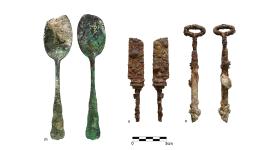Obama Center-Related Construction Halted in Jackson Park
On September 17, 2018, news broke in the Chicago Sun-Times that the City of Chicago had decided to halt construction work and the felling of trees related to the proposed Obama Presidential Center (OPC) in Jackson Park. The work had commenced despite ongoing federal reviews of the project and an earlier pledge from the Obama Foundation that no trees would be removed until all proper permits had been obtained. According to a subsequent article in the Chicago Tribune, the city’s decision came “only after federal officials raised concerns about the work,” with the Sun-Times specifying that it was a “Sept. 11 meeting with the National Park Service and the Federal Highway Administration” that prompted the city’s reversal, noting that “federal agencies [are] becoming more active in reviews.”

The recent news came in the wake of a letter, dated August 8, 2018, from TCLF to the Advisory Council on Historic Preservation (ACHP), the independent federal agency whose primary role is to advise on the nation’s historic preservation policy. The letter raised two significant issues regarding the ongoing federal reviews of Jackson Park. Specifically, TCLF asked the ACHP to exercise its oversight with regard to (1) the felling of trees while federal reviews are ongoing and (2) the Section 106 Archaeological Properties Identification Report (aka, the ISAS report) issued by the Illinois State Archaeological Survey earlier this year. The ACHP then sent a letter to the Federal Highway Administration (the agency in charge of the Section 106 review under the National Historic Preservation Act), dated August 21, 2018, asking that that agency investigate TCLF’s concerns. The city’s recent capitulation on the construction issue may indeed indicate that federal agencies are becoming “more active,” and revisiting the archaeology report may yet prove to be the far more consequential matter.
TCLF challenged the findings of the archaeology report soon after it was made public, suggesting that, contrary to the report, the archaeological remains recently unearthed in Jackson Park are eligible for listing in the National Register of Historic Places, both under Criterion D and Criterion A (and possibly others), because, as the site of the World’s Columbian Exposition of 1893 and a nationally important example of a reform-era park, Jackson Park is a site “associated with events that have made a significant contribution to the broad patterns of our history”—the very definition of Criterion A.

As TCLF’s letter to the ACHP indicated, the ISAS report only considered the archaeological remains from the perspective of Criterion D (pertaining to their general historical significance), and the refusal to consider the sites under Criterion A “represents a failure to analyze the material culture in the larger context of Jackson Park and its cultural significance, both as an historically important, planned cultural landscape and an indispensable national example of reform-era recreational planning.”
TCLF’s position was bolstered by an interview conducted with Dr. Rebecca Graff. Of the seven discrete archaeological sites considered in the ISAS report, three of them were sites excavated and published by her (referenced in the report as sites 11CK1105; 11CK1106; and 11CK1107). The ISAS report “revisited” those three sites, using the very data and archaeological materials that Graff discovered. Because Graff’s excavations (published in 2011) were not conducted in relation to the current federal undertaking (i.e., construction of the OPC and the related road work in Jackson Park), the sites she identified within the park have not been previously evaluated for their eligibility for the National Register of Historic Places. Dr. Graff agreed that the finds are eligible for the Register, adding that the archaeological record is the very resource that promises most to shed new light on what we think we know from the written record, and is therefore of great historical significance.
The Potential Consequences of the Archaeology Report
If the FHWA concurs with TCLF’s position, that would mean that the archaeological remains buried in Jackson Park within the Area of Potential Effects are likely to be deemed a significant historic resource (like an historic building or other feature). Any excavation work for OPC-related buildings or road, etc., would have obvious “adverse effects” on those resources. That finding would, in turn, mean that, going forward, as federal agencies and consulting parties together consider the impact of the OPC, a significant adverse effect will have been documented as a baseline for the joint discussions and reviews. TCLF and others strongly believe that there will surely be other factors also classified as significant “adverse effects” (the 235-foot-high OPC tower and the closing of historic circulation routes, just to name a few), so the procedural question would become how such adverse effects can be avoided, minimized, or mitigated—a question to be determined by input from the consulting parties as reviews continue.

And, perhaps most importantly, If the FHWA concurs with TCLF’s position about the archaeological report, there would be another consequence from the perspective of the federal reviews: The Environmental Assessment (EA) of the federal undertakings in Jackson Park (a document currently in the works) could not reasonably conclude with a FONSI (Finding of No Significant Impact); therefore, the EA, which is scheduled to be presented this winter, would automatically trigger an Environmental Impact Statement (EIS) as mandated by federal procedures.
An EIS is a far more stringent and involved review of the federal undertakings, and, by extension, of the OPC—one that would, regardless of its findings, extend the review process. While every case is different, producing an EIS is also a much lengthier and comprehensive process than producing an EA because an EIS takes a much broader view of the cumulative impacts of a given project, including any and all long-term impacts to the human environment that are reasonably foreseeable. A 2007 study found that in the period from 1998 to 2006, the average time for federal agencies to complete an EIS was 3.4 years. One notes, however, that a recent Memorandum of Understanding penned by the Trump administration specified the goal of completing an EIS within two years of the Notice of Intent to prepare it.
The Editorial Board of the Chicago Tribune recently reminded readers that the OPC is “far from a slam dunk.” That is demonstrably true, and not just for reasons rooted in local politics, which often grab headlines, or because of the constant specter of a lawsuit; rather, it is the long-established, often complex, and sometimes boring minutiae of the National Environmental Protection Act and the National Historic Preservation Act that may yet ensure that nationally significant historic resources like Jackson Park are not sacrificed for short-term ambitions, no matter the direction of political winds. It is worth remembering that it was former President Obama who once declared, “Conservation has been a cornerstone of my presidency.” One hopes that that same pride in the stewardship of the nation’s historic resources will extend to the National Register-listed Jackson Park in Chicago.









